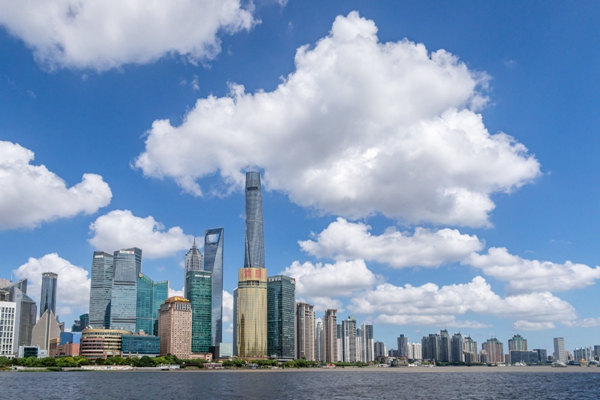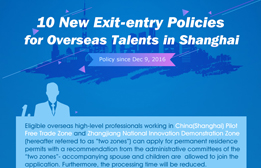Shanghai vows further efforts to attract talent

The view of the Lujiazui area at the Bund in Shanghai. [Photo/IC]
Shanghai is striving to build a complete ecosystem for talent development as it pursues the goal of becoming "a city of dreams".
Shanghai is presently home to 6.75 million talents and has issued 310,000 work permits for foreigners, accounting for a quarter of the country's total.
According to the Shanghai Talent Work Conference held in November, Shanghai will spare no efforts to become a highland for high-level talent and an important talent center in the world.
The city will take the lead in launching a comprehensive reform of the talent development system and mechanism by building a talent ecosystem that is suitable for living, business and entrepreneurship and improving the pyramid-like talent structure.
Providing full support for talent
"The most fundamental reflection of social progress is the transformation of the production mode which is driven by science and technology and relies on smart minds," said Yu Xingan, head of the Chinese Academy of Personnel Science. Yu added that the influence of "strategic scientists" can be seen not only in China, but also in the world.
For Shanghai, a city where many key reform tasks are unveiled, attracting such heavyweight talents is the top priority. To this end, the city will build and improve a number of new R&D institutions and innovation incubation platforms to form a "strong magnet" for attracting talents and create a better talent ecology.
The Zhangjiang Science City in Shanghai has been accelerating the building of major national science and technology infrastructure in the fields of photonics, life sciences, oceans, and energy. Among them, 14 scientific facilities are currently in use or under construction, the most in the country. The amount of investment in facilities and construction progress in Shanghai are also ranked top in the country.
Shanghai will continue to promote the sharing and intercommunication of scientific and technological resources.
The city recently passed revised provisions related to promoting the sharing of large-scale scientific instruments and facilities that will aid with the establishment of an information exchange mechanism. This move will not only help reduce the waiting time to use scientific facilities, but also allow more small and medium-sized enterprises to make breakthroughs in high-end innovations.
New platforms such as the World Laureates Forum, the Zhangjiang Overseas Students Pioneer Park, the Yangtze River Delta Capital Market Service Base and the National Intellectual Property Protection Center also help provide full life cycle support for talent innovation and entrepreneurship and meet the diverse needs of talents.
Gathering global talent
China is accelerating the construction of an important talent center and innovation highland in the world. With the goal of "recruiting and gathering talents for the country" Shanghai, as a city where high-level talent is concentrated, will launch a comprehensive reform of the talent development system and mechanism to make plans that have a broader vision for gathering talent from across the world.
During the construction of an International Talent Development Leading Zone in Pudong New Area, Shanghai will take the lead in implementing a more open and convenient talent introduction policy. It will also launch a batch of pilot measures related to work permits for foreign talents, permanent residency, and remuneration purchases and payments, to build a talent system with global competitiveness.
At No 2377 Shenkun Road in Minhang district, Shanghai, a national-level human resources service industrial park is taking shape. With the concerted efforts of all related parties, the Hongqiao International Business Talent Port has been put into operation to attract global innovative and entrepreneurial talents.
With a focus on "chain service", the place helps entrepreneurs solve difficulties from theory to practice through the linkage and sharing of resources. Take technology trading for example. With the help of the Shanghai International Technology Exchange Market, Minhang district has introduced 34 internationally-renowned technology transfer institutions like the Massachusetts Institute of Technology Regional Innovation Center, and has cultivated 513 technology transfer professionals.
Statistics show that Songjiang has introduced more than 20,000 urgently-needed talents since the start of the construction of the G60 Science and Technology Innovation Corridor. In the first half of this year, the district saw a 144 percent year-on-year increase in the inflow of talents. The district is currently home to 310,000 talents.
In line with the requirements of building a world-class industrial cluster, the G60 Science and Technology Innovation Corridor connects high-end talents with leading industries in the "6+X" industrial clusters, using first-class industrial clusters and major projects to attract and foster talent.
Creating an ideal environment
Shanghai is determined to create a more livable, workable, and creative environment for all kinds of talents.
When recipients of the Young Fellow Award were asked what they would use the prize money for, the responses varied from rewarding their students to paying the down payment on a house to renting laboratories. These varied responses show talent welfare must take into account individual needs and differences. This also means that the authorities must strive to make breakthroughs instead of simply following the norm.
A talent apartment in Changning district recently attracted much attention online as it is built in a famous landmark area in the district and provides various convenient services.
The apartment is a talent service site of the Hongqiao Talent Club. There are 36 similar sites across the district, allowing talent to enjoy nearby talent service.
Special breakthroughs are not only reflected in policies, but also in urban planning. Wang Guocheng, executive vice president of Peking University Science and Technology Park, has conducted field investigations in many innovation clusters around the world, and has been advocating the importance of the integrated development of campuses, parks, neighborhoods, and communities.
In a building with entrepreneurial teams, office spaces, and college clubs, sparks of inspiration are more likely to collide. In his view, Yangpu and Baoshan districts in Shanghai, which have a large number of university resources, are expected to take the lead in exploring such development.

 Print
Print Mail
Mail




